Verizon XV6700 PDA Camera Phone
This is the Camera Hacker web site. So rather than reviewing the PDA/phone functionalities, I am going to review the digital camera portion of this PDA camera phone and anything else that supports the digital camera function. The review will follow the same gripe and rave format that you will find on the rest of this site. And no doubt, there will be comparisons to other camera gadgets that I've used in the past.
The Verizon VX6700 Camera Phone is boxy with rounded corners. Its physical shape is similar to compact digital cameras on the market. The difference is that it has an antenna poking out of it. It's PDA screen serves as the electronic viewfinder and the photo review display. The LCD has a resolution of 240x320.
Photo capturing lens is on the backside of PDA. The tiny lens reminds me of lenses on web cams and disposable digital cameras. The lens is fixed focus. So there is no way to adjust focus manually or automatically.
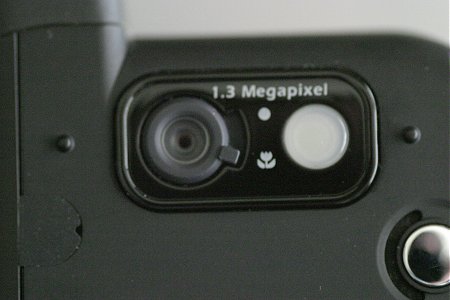
The lens does have a switch for shooting subject at normal distance versus macro distance. However, it's unclear when macro should be used. The instruction manual is written for typical consumer, not for photographers, so there are no camera specifications like minimum focus distance, aperture, shutter speed, etc. After a while, I kind of have an idea on when to use macro. What's surprising is that the lens could focus quite close in macro mode.
There are two ways to enter the camera from the PDA, either hold down the shutter button for two seconds or pull down the Start menu and select Camera. Neither method is good for spur of the moment photographs. The shutter button is convenient but takes way too long. The menu method is cumbersome, which also translates into slowness. They should allow the shutter button to enter camera mode right away. The good news is that you can turn the XV6700 off in camera mode, and the phone will stay in camera mode when turned on.
In place of a flash, the XV6700 camera phone has a video light that works in both photo and video modes. The video light is really just a bright LED. Typically I found it just blinds the people staring at the lens and shed little light on the scene. Seem more annoying than useful. The only situation I can see using it is for macro shots (not macro shots on eyes!).
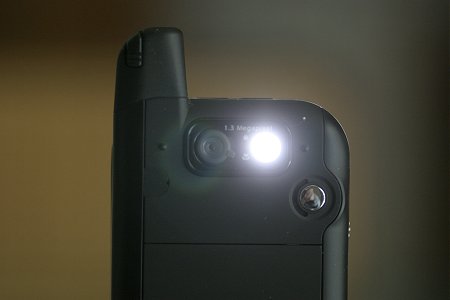
Unlike digital cameras that I have used recently, the XV6700 has a combined white balance and special effects mode selection called "Ambience". You can select among Auto, Daylight, Incandescent, Fluorescent, Night, Grayscale, Sepia, and Cool. It seems like a good idea, since it's pointless to select one of the other color balances in grayscale mode.
The XV6700 camera provides ability to compensate for Contrast, Brightness, Saturation, Hue, and Sharpness in nine steps. There is no way to correlate these steps to photography stops. And the user has to go into two levels of dialogs using the stylus to bring up the adjustment screen. Obviously the designer intended this camera for consumers rather than photographers. However, professional camera manufacturers should take note on providing the same types of compensations on digital cameras and camcorders.
Photo
The XV6700 is capable of capturing a 1.3 megapixel (1280x1024) image. That is low for today's digital camera standard, but is descent for camera phone standard.However, it's 1.3 MP sensor and fixed focus lens doesn't stop me from being envious of my wife's Samsung A940 camera phone with 2 MP sensor and auto-focus lens. In addition to supporting full 1.3 MP images, the XV6700 also supports four other resolutions: Small (160x120), Medium (320x140), Large (640x480), and Scaled (1600x1280). I am not sure what the XV6700 designer meant by "Scaled", but I suspect that the "Scaled" setting provides an 2 MP interpolated image.
A surprising characteristic I found with the Verizon XV6700 is that it has the ability to store images in JPEG or BMP format, a very scarce trait nowadays. Being a data perfection junkie, I always use the lossless BMP format (see my "Shoot in RAW, Always!" article). However, it does take a while to save BMP files to the memory card. In JPEG mode, the XV6700 supports four qualities: SuperFine, Fine, Normal, and Basic. In SuperFine JPEG mode, the camera produces a file that is approximately 224 KB in size. In BMP mode, the camera produces 3.75 MB images.
The shutter button is extremely small. It is also flush with the side of the case, which makes it extremely difficult to find by feel. There is a tremendously long shutter lag. It seems that I can't move the phone until a second after the phone shows the saving file message. It I move it any time before then, I'd get a different picture than I intended.
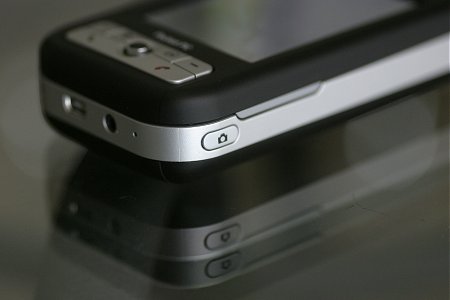
The XV6700 has the ability to place date and time stamp on images. And I'm not talking about embedded date and time in the EXIF. I'm actually talking about the date and time being part of the photograph, like traditional film cameras with date and time stamp features. Although I would probably never use that feature, because date and time are already embedded in EXIF, I thought it's a refreshing feature that could get some use with older folks.
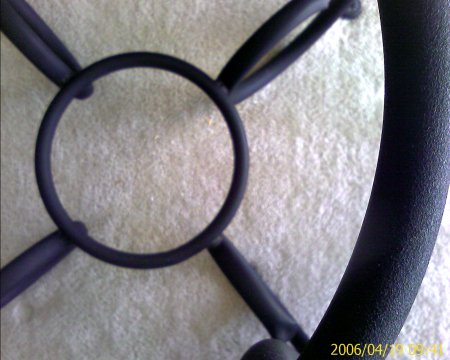
The XV6700 also supports the self-timer function for self-portraits and groups shots. It could be set to 5 seconds or 10 seconds for flexibility. When the self-timer is activated, the LCD counts down by display the number of seconds before triggering the shutter. However, there are no other indications for a self-timer for folks posing in front of the camera. So if the shutter sound is disabled, you'll have to count down mentally.
In addition to self-timer, the XV6700 support digital zooming capability. Although I don't find the digital zoom useful, the XV6700 camera phone does support a six step digital zoom: 1x, 1.2x, 1.4x, 1.6x, 1.8x, and 2x. Of course, the 1x setting means digital zoom is off.
Video
The XV6700 has a video mode and supports three capture formats: Motion JPEG AVI, MPEG-4, and 3GPP2. It also supports three resolutions: Small (128x96), Medium (176x144), and Large (320x240).
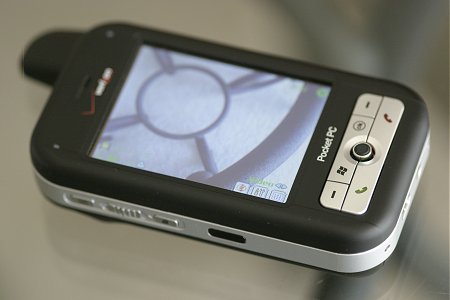
The video mode also supports digital zoom capability. However, unlike the photo mode, it only supports two steps: 1x and 2x.
The XV6700 doesn't place a time limitation on the length of video you can record. It does however give you the ability to enable time limitation based on file size. This is a wonderful trait that I think digital camera manufacturers should learn from when producing digital cameras.
Memory Storage
The Verizon XV6700 comes with 64 MB of built-in memory that is shared between storing photographs/videos taken with the camera and data files from its PDA. Thus, you don't actually need any memory cards to make visual/audio records. However, the XV6700 camera phone also supports a memory card slot. The Verizon XV6700 has a memory card slot for miniSD memory card.
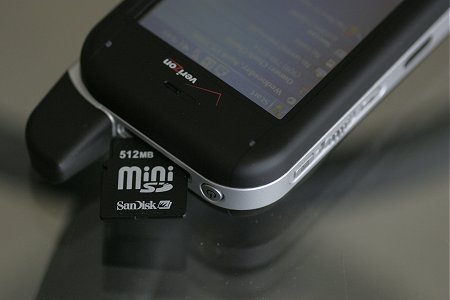
I have SD Cards and TransFlash (microSD) cards around my home. But I don't have any miniSD cards. Why can't manufacturers stick to one media format? Why can't they all use microSD? I ended up buying a 512 MB miniSD at the local Circuit City on sale. I had to pick up a few more memory cards anyway because l am planning a trip to Malaysia (see my "Don't Put All Your Eggs in One Basket" article). Good thing the miniSD card came with a SD card adapter, which lets me use the MiniSD in a regular SD Card slot. I also have a SD Card to CF adapter, so I'll be able to use this same miniSD in a CompactFlash slot (see my "Minolta CompactFlash Adapter for SD Memory Cards SD-CF1" article).
The XV6700 camera phone runs the Windows Mobile 2005 operating system. Therefore, it uses the Windows "My Documents" files structure for storing data, rather than following the DCIM standard used by most digital cameras. The XV6700 camera phone tends to put the photographs in "My Documents\My Pictures", even though "My Documents\My Photos" also exist. I always forget where the photographs resides and have to look in both directories. On the other hand, there is only a "My Documents\My Videos" directory, so it's a little easier to find the videos that I shot. This file structure applies whether you save to the built-in memory or to the memory card.
I like the XV6700's ability to save image/video files with custom prefix in its file names. You have the choice to use a custom string, the date, and the date and time. It makes sorting files based on name extremely easy and automatic.
Carrying Case
The XV6700 comes with a black imitation leather pouch. It's similar to camera pouches that I have used in the past. One size of the pouch has an embedded cardboard. I assume this side is used to protect the LCD screen.
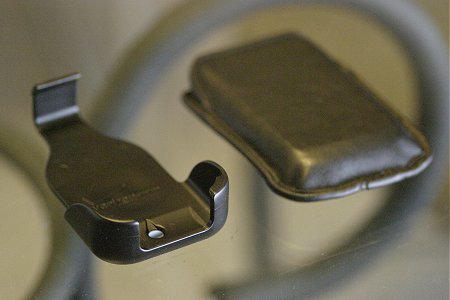
Verizon also has an optional plastic belt holster for the XV6700. I also have this holster. But I like the pouch that came with the XV6700 so much that I never used the holster. On the packaging of the holster, it claims that it works with the HTC 6700. Perhaps that's another model name for the XV6700.
Charger
One extremely cool trait that the XV6700 has is that it has only one wired I/O port: a mini-B USB port (other than the headphone port). Everything is done through that single wired port. You want to transfer data? Plug in the USB cable. You want to charge your phone? Plug in the USB cable.
So to charge the XV6700, you can do it in various ways. One, plug it into the USB wall charger that came with the phone. Two, plug it into your computer. Three, plug it into the docking station.
The XV6700 comes with a great looking docking cradle. It's also weighted nicely so that you won't feel that the XV6700 may topple over when it's plugged in. The docking cradle has two mini-B USB ports on the back. One is for the USB cable, while the second is for the USB wall charger. I was baffled why it needed two USB ports, especially when you can charge the camera phone through the computer. Then I realized it's for times when your computer is off. Because my computer is always on, I didn't have to use the USB wall charger at all.
The nice thing about a camera phone is that you can get car charger cables for the phone. In this case, it's an USB car charger cable. So, this is really the first camera I've got that could be charged on the go.
Related Links
- PCS Phone Audiovox PPC-6700 (Sprint) - Amazon User Reviews
- SanDisk 1GB miniSD Card (SDSDM-1024-A10M) - Amazon User Reviews
- Verizon XV6700 DirectSync Sync and Charge Cable - Amazon User Reviews
- Verizon XV6700 miniSync - Complete Essentials Kit (US outlet plug, ClearTouch Crystal) - Amazon User Reviews
- Verizon XV6700
$10000-above
$5000-$9999
$2000-$4999
$1000-$1999
$500-$999
$200-$499
$100-$199
$50-$99
$25-$49
$0-$24
Gift Certificate

